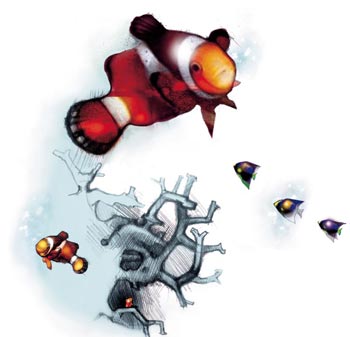The coral reef conundrum
NEW PROJECT: Life in coral reefs. Why are coral reef fishes coloured the way they are?
Biologist Trond Amundsen talks to Gemini reporter Synnøve Ressem:
I’m working with Norwegian, Australian and British scientists to try to find out why coral reef fishes come in such amazing colours.
Many animal species have large colour differences between males and females, with the males usually the most colourful. One explanation for this is the theory of sexual selection. This was Darwin’s second major theory, which says that colours and other extravagant smells, sounds and displays are used to attract partners and to signal status to sexual rivals.
But in some species, the males and females are equally colourful. Biologists don’t completely understand why this is so. Darwin suggested that the females had inherited the gaudy male colours from the males, and that the colours had no function in the females. This is clearly a possibility, as the two sexes share most of their genetic material. But recent research, including work in our group, shows that colours may indeed have a function in females – both in mate attraction and competition. For once it seems that Darwin was wrong, or at least partly so – he might have benefited from a bit more of a “female perspective”.
Usually it is the males that check out the females. But under certain conditions it is quite the opposite, as in pipefishes where males care for the offspring and females compete for males. Other times we may be witnessing a kind of equality, where both sexes are picky in their choice of mate. Sometimes the most colourful females are the most popular among males, as we have seen in the small gobies that we study in Scandinavia.
During the last decade, we have learned a great deal about the importance of colour in animals. But there’s still much that we don’t understand properly – one example being female coloration. It’s the way things are science: You answer one question, and many more pop up.
CORAL REEF FISH
- NEW PROJECT: Life in coral reefs. Why are coral reef fishes coloured the way they are? What is the significance of the colours?
PROJECT LEADER: Trond Amundsen, Department og Biology, NTNU. - COLLABORATING SCIENTISTS: Dr. Elisabet Forsgren, NINA Trondheim, Professor Ivar Folstad, The University of Tromsø, researchers at the University of Queensland, Australia and Imperial College, England.
Biologist Trond Amundsen
That’s what has brought us to work on coral reef fishes. Tropical coral reefs are surprisingly little studied. For example, there hasn’t been much research on sexual selection among coral reef fish. One thing that is notable on the reef is that in many species, both sexes are brilliantly colourful. Throughout history, scientists have proposed several possible explanations.
Coral reefs are highly diverse and home to between 4 000 and 7 000 fish species, often with hundreds of species in a very small area. Perhaps the colours serve to make sure that the animals can see which species is which and find the right species to mate with?
Another theory is that the colour acts as camouflage. This may certainly be right in some cases, but I doubt that it is the whole explanation. I think it’s more likely that the colours are used for identification. Coral reef fishes reproduce throughout the year, and they live in the same restricted area. We want to test the idea they need colours to defend their territory, say who they are and show off to competitors and potential mates.
“It’s terrible to think that we risk losing many of our tropical coral reefs … before we realize what we have and what it means.”
We know that colour is central to communication. But which kind of communication is most important? Is it most important to broadcast who you are, to show that you are healthy and strong and potentially a good mate – or is it something else? Perhaps the use of colour as a means of communication partly explains why we have so many species of fish on the reef?
Some might wonder why it is important to study this. For us, the major drive is a desire to understand nature. Tropical coral reefs are now threatened by a warmer climate, ocean acidification, overfishing, and sediments from rivers and other runoff. Most coral reefs are on the coasts of not-so-rich countries like Indonesia and the Philippines. Developing countries like these cannot nor should carry the main responsibility for studying and conserving coral reefs. I think that rich countries like Norway have an obligation to contribute to studying the many interesting processes and phenomena on reefs. It’s terrible to think that we risk losing many of our tropical coral reefs before we maybe realize their value and understand their biology.
We can compare the coral reefs to the similarly rich rainforests, which are perhaps more widely appreciated for their biodiversity.
We know that tropical rainforests have a global significance for our climate and because of their exceptionally rich flora and fauna. Many of the organisms of the rainforest can be used for human benefit, such as a source of new medicines.
Coral reefs have higher vertebrate biodiversity than any rainforest. Science needs to make serious efforts to understand this important environment and the animals living there before it’s too late. It is very satisfying to be a part of such efforts.
Synnøve Ressem





